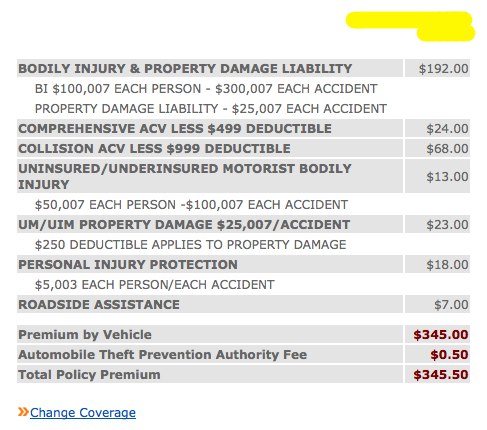Difference Between Comprehensive and Collision
In insurance both the comprehensive and collision terms are very popular when discussing matters related to vehicles. They are both different types of covers that protect vehicles against the losses incurred during the vehicle usage. None of the two can be mandated, however the cover could be deemed compulsory when the bank is financing the purchase.
Some insurance companies offer both of the covers as a package while others give the option of choosing one. Getting a better understanding both of the covers is essential to anyone who wants to purchase a vehicle. While some insurance policies offer both as a package, some offer the option to purchase each cover independently.
What is Comprehensive Insurance?
The comprehensive insurance cover just as the name suggests covers a great deal of damages that could occur with your car. A comprehensive insurance is a cover that can actually replace of pay the repair costs when your vehicle is damaged, stolen or involved in a damaging incident that isn’t a collision.
This coverage protects the vehicles against damages from fire, vandalism, riots, damages from animals, natural disasters such as storms or even falling trees. This cover is usually compulsory when a banker any other lender is financing the purchase of the car, however when you own the car this is optional. However, there are a couple of things this insurance does not cover:
- Medical Expenses for the driver, passengers or any other party during an accident.
- Damages on your car from accidents and collisions
- Damages to any other party’s car from collisions
Once you purchase the insurance cover, a deductible is set. In the case that an accident happens that matches up to any of the incidents listed above the insurance will pay for the damages less the deductible amount. In the case that the car has to be replaced, the insurer will pay for the cost of the car at purchase less the depreciated amount.
What is Collision Insurance?
This is an insurance cover that pays the repair cost or fully replaces your vehicle if it gets damaged during an accident with an object such as fences or another car. This insurance cover is compulsory when a financial institution is financing your vehicle and optional when you are fully financing it individually. This insurance covers the repair cost or replacement costs of vehicles involved in collisions with other cars, collisions with trees or any other object, any single-car accident such as rolling or falling over. Just like the comprehensive insurance, there are certain elements that are not covered by your insurance under this policy. They include:
- Damage that are not related to driving
- Medical bills of any party involved in the accident
- Damages in any other person’s vehicle
- Damage to another individual’s property e.g fence
The process of purchasing this insurance cover starts at the point where your car is valued. Once valuation is made, a deductible is agreed upon and once paid the insurance cover begins. If you get into an accident related to any of the situations listed above the insurance company will pay you the repair cost less the deductible amount agreed upon. Replacements are also done in a similar manner to the comprehensive insurance, where the amount is paid less the depreciation value.
For example, if your car gets into an accident with another and the repair value is $1500 and the deductible rate is $300. Your insurance will pay you $1200. Another example is say, a car valued at $12000, with a depreciated rate of 8% yearly and a deductible of $400. If that car gets into a car accident after a year and is written-off, which means it can’t be repaired, the insurance will pay;
8% * $12,000 = $960
$12,000 – $960 = $11,040
$11,040 – $400= $10,640
The total amount the Insurance will pay is $10,640. If the owner wants to buy a new car they would still have to top up.
Differences Between Comprehensive and Collision
There are not so many differences between comprehensive and collision insurance covers.
However, a few elements stand out:
-
Coverage involved in Comprehensive and Collision
The collision insurance only covers incidents that are related to colliding with another car or object. Comprehensive insurance does not cover collisions with other cars, but damages from several incidents such as fire, vandalism, falling objects and natural disasters. It also covers theft.
-
Situation involved in Comprehensive and Collision
It is compulsory for the car to be compensated during a collision insurance to have been driven at the point of the accident. In comprehensive the incident should not have necessarily happened when the car is being driven.
-
Elements covered in Comprehensive and Collision
Comprehensive covers much more incidents compared to collision insurance which only covers crashes.
Comprehensive vs. Collision : Comparison Chart
Summary of Comprehensive and Collision
- The collision and comprehensive insurance covers are both related to preventing losses incurred during car accidents.
- Comprehensive insurance covers more situations; any situation not related to a collision with another car qualifies.
- Collision only covers car crashes with another car.
- Compensation on both cases is done less the deductible amount during repairs. During replacements, the deductible and the depreciated value is deducted from the initial car value.
- Choosing a higher deductible reduces your premium amounts.
- Difference Between S Corp and C Corp - September 9, 2018
- Difference Between Terrace and Balcony - September 9, 2018
- Difference Between Anabaptists and Evangelicals - August 31, 2018
Search DifferenceBetween.net :
Leave a Response
References :
[0]Dionne, G., & Harrington, S. E. (1992). Foundations of Insurance Economics: Readings in Economics and Finance. Springer Science & Business Media.
[1]Kunreuther, H. C., Pauly, M. V., & McMorrow, S. (2013). Insurance and Behavioral Economics: Improving Decisions in the Most Misunderstood Industry. Cambridge University Press.
[2]Williams, E., & Atkins, R. A. (1994). Essential Math: Basic Math for Everyday Use. Barron’s Educational Series.
[3]Image credit: https://www.flickr.com/photos/jessicamullen/4142372226
[4]Image credit: https://pxhere.com/en/photo/535822



